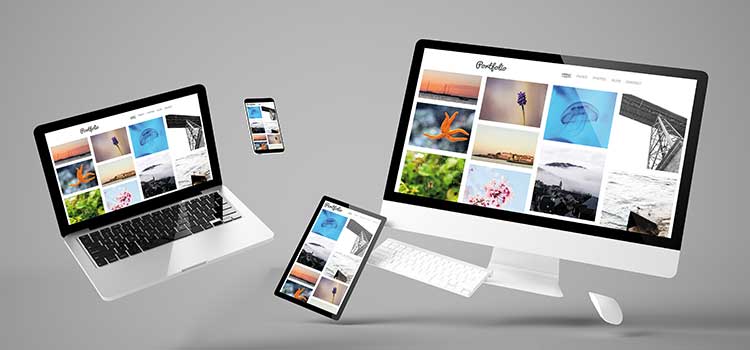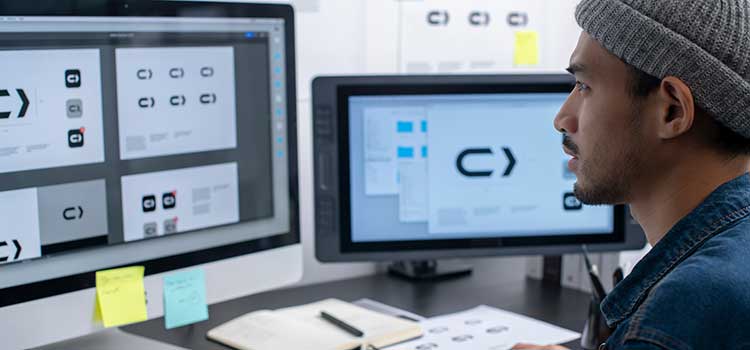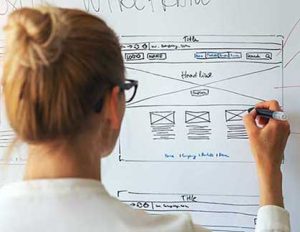How to Become a Web Designer
Career paths, education and salaries

What does a web designer do?
In most cases, the web or digital designer is the first stop toward determining the look and feel of a website, creating its layout and design, incorporating color and branding—and essentially making a site look great and function responsively.
As such, website designers usually have knowledge of UI, or user interface, which means they strategically design a site that's intuitive and easy for visitors to navigate, and UX, which is user experience, so that users can find, buy or navigate to what they want, easily and logically.
Some of their job duties may include:
- Designing and layout of a website with emphasis on mobile responsiveness
- Thinking through the navigation and logic of a site to provide the best user experience while also accomplishing business goals
- Designing page templates and creating wireframes and mockups
- Working in Adobe Creative Cloud to create visual elements, graphics and animations
- Researching and registering web domains
- Organizing photo libraries and site files
- Collaborating on website versions, updates and visual branding refresh
- Coordinating with developers, QA testers, content providers and other designers to create the end product site
Reasons to become a web designer
If you're an artist who innately looks for visual solutions to design problems and you also enjoy technology, a career in web design may be the best of both worlds. Web design allows you to not only stretch your creative wings but also keep up with the latest technology and standards.
In addition, business and communication skills are indispensable. As a web designer, you'll work with clients, developers, content teams and marketing departments, and to be successful, you'll need to be flexible and articulate your design vision effectively. Here are just five reasons to enjoy a web design career:
- Feed your creative side. From graphics to color schemes, website design jobs let you use artistic skills in your day-to-day work. If you have an excellent aesthetic sense and are detail-oriented in your design approach, then Web design might be a good match. Plus, designers who work for agencies rarely get bored because most projects require something new.
- Work on the web. Being a web designer enables you to not only work with websites every day but also to shape the way people interact with them. Plus, these days, a customer's first impression of a company is often through its website rather than print materials such as business cards or marketing mailings. Working with the Web as your medium allows you to make a big impact on a company's brand. The Web is always exciting because the industry changes frequently and best practices emerge and are fine-tuned, trends take hold and technology updates.
- Use sophisticated technology. If you enjoy using computers and design software, then web design jobs will provide the opportunity to do so. And you won't get bored working only with design software because web designers typically need to know HTML, CSS and JavaScript.
- Be independent. Although many designers work in-house for large organizations or are part of a design firm's staff, there are also many opportunities to work for yourself. Being self-employed allows you to pick what clients you want to work with, set your rates and work hours, specialize in websites for a certain business industry and hone your business and marketing skills.
- Work in a growing industry. Every company needs a website and wants to keep it looking current, which puts web designers in high demand. The U.S. Bureau of Labor Statistics, in its current Occupational Outlook Handbook, states that employment for web and digital interface designers is projected to grow 16.3% through 2031, which is much faster than average for all occupations.
Steps to becoming a web designer
Earn a bachelor's degree.

You may be able to enter the field with an associate degree or certificate, but if your ambition is to be self-employed or contract your talent out to companies, earning a bachelor's degree can give you additional skills to help you manage your business and time and better understand your client's needs.
Create a web design portfolio that dazzles.

The first thing a potential employer will see is you—and a portfolio of your work. Use your best digital design work that represents your unique skills and talents, whether they be video or AI-design. Make sure your portfolio is diverse, representative of who you are and features the breadth of your skillset.
Find a web design job or start your own business.

There are several professional resources for web designers and some feature job boards. Networking at industry events is always a solution to finding work, and we have several to consider later in our article. We also have tips for starting a business if you want to become self-employed.
Consider bootcamps and professional certifications to advance.

You've chosen a field that never stops evolving and changing, so earning professional certifications is a great way to learn new skills and advance your knowledge. Some certifications are self-paced, so you'll need great online study skills. Here are just a couple to consider:
• Adobe Certified Expert
• Azure Developer Associate, Microsoft
• PMI Agile Certified Practitioner
• CIW Web and mobile design certifications
• UX certification, NN/g
• IBM AI for Design certification badge
Is a degree necessary for a web designer?
Even if you're filled with innate raw talent as a designer, it may not be enough to propel you into that dream web design career. Why? Great web designers possess more than creative gifts—they are masters of intuiting how users actually use a website, and they strive to create a holistic and organic experience that meshes the client's intentions with that ultimate user experience. In short, they are both visually visionary and pragmatically ecommerce minded.
While you'll supply the visual gifts, a web design degree program can help you gain and master the skills you'll need on the business, ecommerce and web interaction side. A good web design program will not only teach web programming and web standards basics, but flesh out your education with coursework in English, mathematics, psychology (great for understanding how users tick) and physics.
Can I take a web designer degree program online?
The good news is yes. More and more colleges and universities are offering complete online and accredited design degree programs. You won't miss out on anything by studying at home. And just like traditional schools, those interested in getting a formal website design education online can earn a certificate or associate, bachelor's and master's degrees.
Career paths
The web design universe has expanded beyond basic website design, and mobile and UI/UX have emerged as platforms and areas of dominance in the field. Companies such as AWS help manage and produce products for large and small companies, and technologies change constantly, which makes the field of web design both ever evolving and challenging. Here are just a couple of areas that continue to thrive in this huge universe:
Multimedia design
Multimedia design is a creative field that involves integrating various forms of media, such as text, images, audio, and video, to effectively communicate with an audience. It is a specialized practice within the graphics and website design industry, finding applications in diverse sectors like advertising and marketing.
One of the most exciting areas of graphic and web design, and one of the fastest-growing occupations in visual arts. Multimedia designers have the enviable job of combining various types of media, including text, images, audio and video, in order to communicate information to an audience. Their jobs allow them to bridge the gap between multiple disciplines, making multimedia designers an attractive choice for clients.
From websites to television and movies, and video games to interactive learning software, multimedia designers use their skills in graphic design, animation and technology to create products that entertain and inform.
There's a diversity of careers in the multimedia design field. You can expect to utilize different visual and technical skills, such as imaging programs or animation software, depending on your specialty within multimedia design:
- Multimedia Art and Animation:
Multimedia artists and animators use computer software as well as traditional media to create animation, special effects and other graphics used in films, television, video games and websites. - Multimedia Design: Multimedia designers synthesize different media sources such as images, animation, sound, text and data to create a complete and integrated media product.
- Multimedia Web Design and Development: Professionals in multimedia design for the web use their skills in manipulating graphics, video, animation and layout to create interactive web and mobile environments that meet the client's specifications.
- Multimedia Publishing and Production: Publishers and producers have more of a project management role, overseeing the business side of a multimedia project—staffing concerns, budget, marketing and so on.
- Multimedia Game Programming: Multimedia game programmers have the technical knowledge to construct video game animations, characters and environments, and put them together to create a finished product.
- Multimedia Instructional Design: In the field of education, multimedia design is used to create instructional materials that utilize a combination of visual, auditory and interactive teaching methods.
Interactive design
It wasn't long ago that interactive media primarily referred to video and computer game design or the development of websites. In a few short years, though, we've seen the rise of mobile devices that have brought interactive media not only to our fingertips but into our pockets. Despite uncertainty in the face of current technological innovation, there are a few areas that everyone seems to agree are available to pursue:
- Apps for professionals and students, from medical exams to textbooks on your phone
- Interactive movie and music tie-ins with bonus content and games
- Augmented reality apps such as GPS navigators and travel guides for your phone
- Increasingly personalized marketing that ranges from interactive catalogs to holographic advertisements
- Design for AI, which is new, ever-changing and non-static
Starting your own web design business
Starting a business requires thought, planning and education beyond the scope of web design. Here's how earning a bachelor's degree instead of an associate or a certificate can actually help you get there faster.
In a bachelor's program you'll likely have the option to take classes in other areas besides design, that can help you understand the complexities of owning and running a business. Classes in business management and accounting, psychology and physics will give you the skills to handle finances, loans and payroll, among other business-related topics—and possible provide insights into your clients' needs and wishes for their websites.
Here are seven tips for starting a successful web design business.
- Take inventory.
- Before putting your web design plans into action, ask yourself whether you've got what it takes to start your own business. The U.S. Small Business Administration's website has a list of questions for potential entrepreneurs. Though it's exciting to be your own boss, you need to be very dedicated to ensure that you put enough time into your business to make it succeed.
- Target your web design niche.
- Not only are there several different careers that fall under the umbrella of web design—such as web graphic design, interactive media design, AI design and user interface design—there are also different market segments you can target with your design business.
- Get the right training.
- Web designers generally need some level of web design education—a certificate or associate degree may be sufficient if you have enough experience under your belt, but a bachelor's degree or even a master's degree can be an enormous benefit if your goal is to start your own business.
- Invest in the proper equipment.
- Although you don't need a ton of expensive equipment to get started in the web design field, you do need to invest in some basics: an internet and WiFi connection, a sufficiently powerful computer and appropriate design software.
- Cultivate a business mindset.
- Running a web design business is similar to operating any other type of small business. You'll need patience and great communication skills to work with a variety of clients and the creativity to address design problems in a way that meets the client's needs.
- Take care of the practical details.
- Do you have an appropriate home office space or other workspace? Do you need a business license to operate as a freelance web designer? Have you written a business plan to define your goals in a concrete way? You'll need this for any business loan you take out.
- Grow your business.
- Once you've gotten started, you'll need to make sure you can maintain a steady flow of clients and income. Common ways to drum up clients include networking, traditional marketing and word of mouth.
8 Tools you'll use
A good website designer will be well-versed in the tools of the trade, and while some tools remain staples and pioneers in the industry, there are always new and better tools to master. Here are just eight tools you can expect to use on the job:
- Adobe XD:
- An excellent wireframing tool that integrates with the rest of Adobe's Creative Cloud, XD includes drawing tools, non-static interaction definition, desktop and mobile previews, and sharing tools so you can elicit feedback from other teams and stakeholders.
- Figma:
- A newish to the market feature-loaded tool that many designers choose for their interface design and prototyping.
- Photoshop:
- The long-time industry pioneer and leader for photo editing, graphic design, interface design, video editing and more.
- ProofHub:
- All digital and web designers should check and QA their work before releasing it and ProofHub helps them to do just that.
- Sketch:
- One of the most popular interface designer tools due to its ability to intuitively create accurate, high-fidelity mockups.
- A CMS, such as WordPress:
- Whether you're building websites in a proprietary CMS or a product such as WordPress, you'll spend most of your time installing, editing, customizing and building out your theme and site in your content management system of choice.
- Google Web Designer:
- Intended for businesses, Google Web Designer provides the capacity to create engaging videos, images and HTML5-based designs that can run on desktop, mobile and tablet.
- Bootstrap:
- For the hand coder of websites, Bootstrap includes a free library of HTML, JavaScript, and CSS templates that makes coding a website from scratch easier and less painful.
What makes for a great web designer?
There are some basic traits and skills that you'll need to work as a web designer.
| You are… | Skills you should have… |
|---|---|
| Creative | Communication skills |
| Original | Technical skills |
| Visual | Business skills |
| Detail oriented | Listening skills |
| Adaptable | Analytical skills |
| Able to handle criticism | Time-management skills |
| Customer oriented | Marketing knowledge |
The online tech journal UpCity polled leaders in the web design field about what traits and abilities promoted designers to the top of their game. They published the results in their blog article, 20 Qualities of Top Website Designers. Here are our seven favorite traits that are sure to set a web designer apart from the crowd:
- Remington Begg, CEO of Impulse Creative: Have knowledge of key principles. Begg says, "Good web design principles are rarely innate, which means they almost always have to be learned."
- Ben Hunt, Internet Marketing Expert: Be self-learning. "The best designers…they're all learning every day, trying out new stuff, learning what works and what doesn't."
- Raini Setia, Mass Communication Post-graduate: Find solutions. "Getting stuck is part of handling things and a good designer looks for solutions not just alternatives."
- Nick Pettit, Designer and Teacher at Treehouse: Tell a story. "Websites are a communication medium, so clients want to see work that really says something."
- Randall Parrish, the Web Development Group: Be collaborative. "Bouncing ideas off one another throughout the design process only serves to make the final deliverable all the more refined."
- Penina Finger, Owner of Fantastic Machine Design Studio: Design for emotion by doing your homework. "Not only do your customers have feelings, but they have feelings which can't be captured in a single word."
- Isaac Campbell, Lead Designer at Fannit: Pay attention to the little things. "Incredibly observant people make the best designers. Their ability to see small details of a larger picture is indispensable."
Meriel Mayo, a Commerce IET-UX Designer at AWS, has all the skills and abilities these designers suggest, and we asked her to list what she considers the five top traits for success in the field. Here are her recommendations:
- Understand your market and audience (research, research, research).
- Know how to communicate effectively on the vision, and how to present your ideas to a group of people.
- Be a visual visionary and visual storyteller to help others see.
- Keep an eye on what's going on around you in technology, design trends and other emerging areas.
- Be process oriented and have a good methodology that others can adapt to.
Differences between a web designer and developer
Web development and design are often used as interchangeable terms, but although some of their duties overlap, web designers and web developers work in two distinct spheres of website production.
While different, web designers and web developers work hand in hand to create a visually pleasing and structurally sound website, it might help to picture a Venn diagram—in one circle are web designers, who are experts in the graphics and layout of a web page, and in the other circle are developers, who build and program the technical aspects of the site.
Where the overlap happens
You can usually be a great designer or developer, but it's rare to find one person who excels at both. In the overlapping intersection of our Venn diagram are some skills that both jobs know and use, and may include:
- Most developers and designers are familiar with HTML5, CSS and JavaScript.
- WordPress and other content management systems allow someone to do both design by selecting themes and development by adding widgets and plug-ins.
- Designers and developers have the common goal of websites that have good usability and accessibility.
- Both work with content producers.
- If you're looking at web development and design careers but aren't sure which direction to focus on, take a look at the following chart for a side-by-side comparison.
| Web development | Web design | |
|---|---|---|
| Sample job titles | Web Programmer, Web Developer, Information Architect, System Administrator, Project Manager | Web Graphic Designer, User Interface Designer, Webmaster, Content Developer |
| Job duties | • Writes the code to implement the design of a page or an entire site • Builds and maintains databases and other tools needed to operate the site • May oversee a site's servers, hardware or software, or assist with website security • May supervise other web developers as part of a team | • Creates web page content such as text, audio and video • Designs the visual look and feel of websites, from layout to color to graphics • Assists with the navigation and usability of a website • Helps maintain and update site content |
| Skills needed | • Knowledge of website building languages like HTML and CSS as well as scripting languages • Knowledge of programming languages for more complex, database-driven content, such as Perl, ASP, PHP and Java • Basic business and communication skills to collaborate with designers, marketing and others | • Training in art and design fundamentals • Basic knowledge of web programming languages such as HTML and CSS • Knowledge of software such as Adobe, Figma and Sketch • Business and communication skills to work with developers and/or clients |
| Education | • Certificate, associate degree or bachelor's degree in web development or web programming, OR • Associate degree or bachelor's degree in computer science | • Certificate or associate degree in web design or interactive design, BUT • Preferably and for more advanced positions, a bachelor's degree |
| Median annual salary | $84,960 | $98,540 |
Web designer salary and job growth
The U.S. Bureau of Labor Statistics says web and digital designers held over 111,000 jobs in 2023 and have a higher than the national average job growth rate. The BLS says the top employers of web and digital designers are:
- Computer systems design services
- Software publishers
- Retail trade
- Finance and insurance
- Advertising, public relations and related services
Salaries for web designers are equally impressive, with a median annual salary of $98,540. Salaries generally depend upon years of experience, location and education. You can look at salaries by state here:
National data
Median Salary: $98,540
Projected job growth: 15.2%
10th Percentile: $48,210
25th Percentile: $66,020
75th Percentile: $139,500
90th Percentile: $176,490
Projected job growth: 15.2%
State data
| State | Median Salary | Bottom 10% | Top 10% |
|---|---|---|---|
| Alabama | $43,150 | $31,860 | $99,940 |
| Alaska | $69,650 | $50,630 | $97,810 |
| Arizona | $86,060 | $45,860 | $173,920 |
| Arkansas | $49,450 | $30,010 | $112,230 |
| California | $127,760 | $59,310 | $210,500 |
| Colorado | $100,070 | $58,130 | $162,720 |
| Connecticut | $71,080 | $50,140 | $128,410 |
| Delaware | $63,200 | $39,980 | $101,920 |
| District of Columbia | $104,410 | $35,080 | $141,290 |
| Florida | $80,150 | $47,320 | $151,280 |
| Georgia | $97,820 | $50,360 | $163,650 |
| Hawaii | $77,040 | $39,860 | $119,390 |
| Idaho | $52,830 | $37,440 | $95,200 |
| Illinois | $69,750 | $40,710 | $134,040 |
| Indiana | $58,970 | $31,610 | $105,400 |
| Iowa | $69,290 | $37,510 | $130,560 |
| Kansas | $67,060 | $40,160 | $138,010 |
| Kentucky | $111,660 | $45,050 | $130,680 |
| Louisiana | $54,810 | $41,070 | $91,860 |
| Maine | $84,640 | $48,330 | $103,360 |
| Maryland | $85,560 | $55,940 | $136,310 |
| Massachusetts | $107,010 | $66,390 | $168,330 |
| Michigan | $73,180 | $33,720 | $126,100 |
| Minnesota | $80,440 | $45,370 | $134,710 |
| Mississippi | $67,560 | $37,990 | $135,340 |
| Missouri | $72,130 | $31,200 | $124,990 |
| Montana | $80,080 | $28,070 | $153,130 |
| Nebraska | $59,860 | $31,430 | $104,700 |
| Nevada | $94,840 | $47,100 | $179,250 |
| New Hampshire | $83,820 | $46,380 | $131,430 |
| New Jersey | $85,630 | $49,000 | $158,350 |
| New Mexico | $59,390 | $41,270 | $149,990 |
| New York | $117,090 | $62,000 | $200,440 |
| North Carolina | $83,040 | $49,660 | $135,960 |
| North Dakota | $65,540 | $48,420 | $115,610 |
| Ohio | $80,100 | $45,570 | $148,530 |
| Oklahoma | $57,050 | $36,020 | $102,940 |
| Oregon | $97,140 | $64,290 | $161,940 |
| Pennsylvania | $78,920 | $44,780 | $142,200 |
| Rhode Island | $98,810 | $55,040 | $159,070 |
| South Carolina | $70,080 | $43,120 | $123,830 |
| South Dakota | $119,600 | $65,940 | $128,120 |
| Tennessee | $60,080 | $35,240 | $121,040 |
| Texas | $105,760 | $45,520 | $145,600 |
| Utah | $101,060 | $45,910 | $167,040 |
| Vermont | $96,490 | $62,150 | $99,340 |
| Virginia | $78,670 | $44,260 | $131,510 |
| Washington | $103,480 | $54,080 | $191,950 |
| West Virginia | $54,920 | $36,920 | $118,300 |
| Wisconsin | $91,820 | $52,350 | $141,510 |
| Wyoming | $107,530 | $50,290 | $107,530 |
Source: U.S. Bureau of Labor Statistics (BLS) 2023 median salary; projected job growth through 2032. Actual salaries vary depending on location, level of education, years of experience, work environment, and other factors. Salaries may differ even more for those who are self-employed or work part time.
Since geographic location plays an important role in what you can earn and where the jobs are, the BLS cites the following metropolitan areas as having the highest level of employment for web designers:
| Metropolitan Areas | Employment |
|---|---|
| New York-Newark-Jersey City, NY-NJ-PA | 13,820 |
| Los Angeles-Long Beach-Anaheim, CA | 8,310 |
| San Francisco-Oakland-Hayward, CA | 7,140 |
| Seattle-Tacoma-Bellevue, WA | 6,400 |
| San Jose-Sunnyvale-Santa Clara, CA | 3,870 |
| Washington-Arlington-Alexandria, DC-VA-MD-WV | 3,590 |
| Dallas-Fort Worth-Arlington, TX | 2,210 |
| Chicago-Naperville-Elgin, IL-IN-WI | 2,160 |
| Atlanta-Sandy Springs-Roswell, GA | 2,120 |
| Boston-Cambridge-Nashua, MA-NH | 1,990 |
Groups to join
There are many groups for web designers, some regional, but there are national associations that can help with skills and certifications, job board postings and general networking. Some of the most known are:
WordPress Meetup groups: There are regional and in almost all major cities meetups around the U.S. The good news is many of them are online so once you join you can log into the meeting.
AIGA: The professional association for designers has networking and educational resources, professional development and a job board.
International Web Association: The industry leader in professional certifications and industry standards with over 300,000 members all over the world.
American Webmasters Association: For web designers, web developers, online marketers, website managers and other web professionals.
Web Professionals: A friendly site that features certifications, blogs and a social network.
Getting started
Comparing web design schools and choosing the right one for you are important first steps in your journey to getting the web design job you want. As you look at website design education programs, keep your priorities in mind. Should you choose a shorter program that will allow you to enter the workforce sooner? Or do you want the well-rounded education that a bachelor's degree can provide?
If you feel sure that a web designer education is the way to go to meet your future goals and aspirations, your first step is to find the right degree or certificate program for you. Our list of accredited schools can help you on your way to a coveted career in web and digital design.
Published: May 19, 2023

Written and reported by:
All Art Schools Staff
UX Designer Degree & Career Guide
You may also like

How to Become a Web Designer

UX Design Degrees

